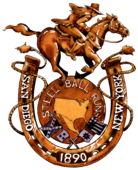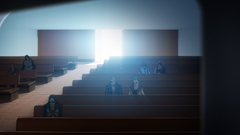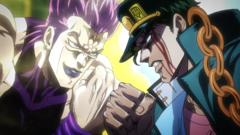User:FTR/Canon in JoJo

|
Note: This is a user's personal page attached to their profile! This is not an actual article, may not be related to JoJo or Araki, and is not associated with the wiki. As such, it may not adhere to the policies. |
Throughout JoJo's Bizarre Adventure publication history, there have been numerous adaptations, one-shots, spin-offs and light novels based in the universe of JoJo. Purple Haze Feedback, and Rey Infinito for example, focus on the adventures of Panncotta Fugo and Lisa Lisa respectively. Though there are no official rules regarding the canonicity of these works, the Wiki doesn't take a stance way or the other, they aren't written by Araki but unless they contradict some elements of his work, they are possibly canon.
When speaking of the works written by Araki himself, there are two continuities and multiple spin-offs written by Araki himself that are considered canon by the wiki.
Original Continuity
The original continuity is the original world within the setting of JoJo's Bizarre Adventure. It encompasses Parts 1-6 and a number of spin-offs. It tracks the original Joestar family's many periulous adventures, the legacy of DIO and the ancient supernatural arrows. Many themes of the original continuity deal with fate, power and the supernatural.
Following Part 4 specifically, Araki wrote a number of on-going one-shots revolving around the character Kishibe Rohan named Thus Spoke Kishibe Rohan, facing numerous supernatural beings within Morioh. Alongside Deadman's Questions starring the ghost Yoshikage Kira as he manages existing in a world with no memories of his past or any destination in the future.
Araki has directly contributed to a number of works based on the original continuity, for advice, art or simply to overlook the development of the project.
Second Continuity
The second continuity is an alternate world within the setting of JoJo's Bizarre Adventure. It encompasses Steel Ball Run, JoJolion, and The JOJOLands. There are a number of names, events, roles, personalities, and relationships appearing in Steel Ball Run and JoJolion similar to those in the original timeline.Hirohiko Araki indicates in the All-Star Battle guidebook that Diamond is Unbreakable and JoJolion are parallel worlds not linked in time or space, and that their respective characters will never meet each other in the manga, including both Josukes and Rohan.[1]
Non-Canon (?)
Adaptations
JoJo's Bizarre Adventure has been adapted a few times into film, Anime and video-games. Considering the nature of these projects, they don't affect the timeline or events illustrated and written by Araki in the manga itself. They are simply adaptations with no bearing on the original author's intent, and they may or may not be considered canon.
The Anime, takes many liberties when depicting the characters, the story and even the series of events. For example, Fugo's backstory is described differently in Purple Haze Feedback and the TV airing; the manga doesn't portray it in-detail, so when it came to expanding his origins all was fair-game and both of these were origins were approved by Araki himself. It is a matter of interpretation and either is completely acceptable.
What About Colors?
As stated by Araki, JoJo has no canon colors; Jotaro doesn't have dark hair and Crazy Diamond isn't salmon pink. When it comes to color design, it's completely up to the author, or artist to breath drama into whatever they're trying to depict. The Anime portrays this design philosophy in its numerous color shifts.
Trivia
- Araki conceived the idea of the alternate universe present in Parts 7-9 towards the end of Stone Ocean's serialization, likening the concept of a series returning to its roots to the Italian Renaissance.[2]
References
- ↑ All-Star Battle Guidebook Interview
- ↑ SO Volume 11 (Bunko Edition) Afterword





